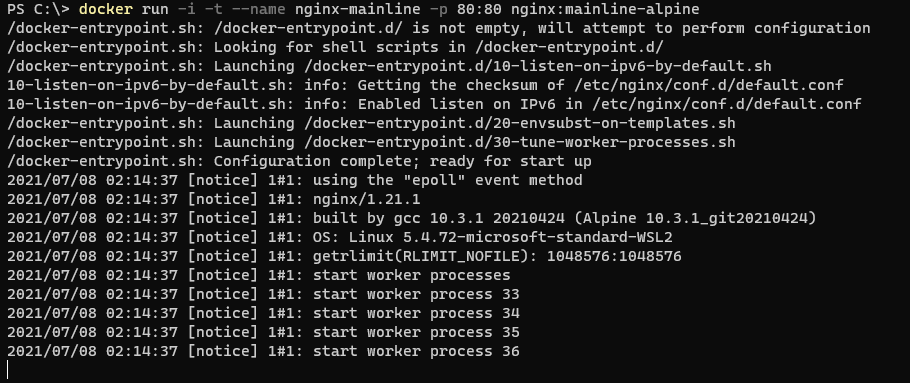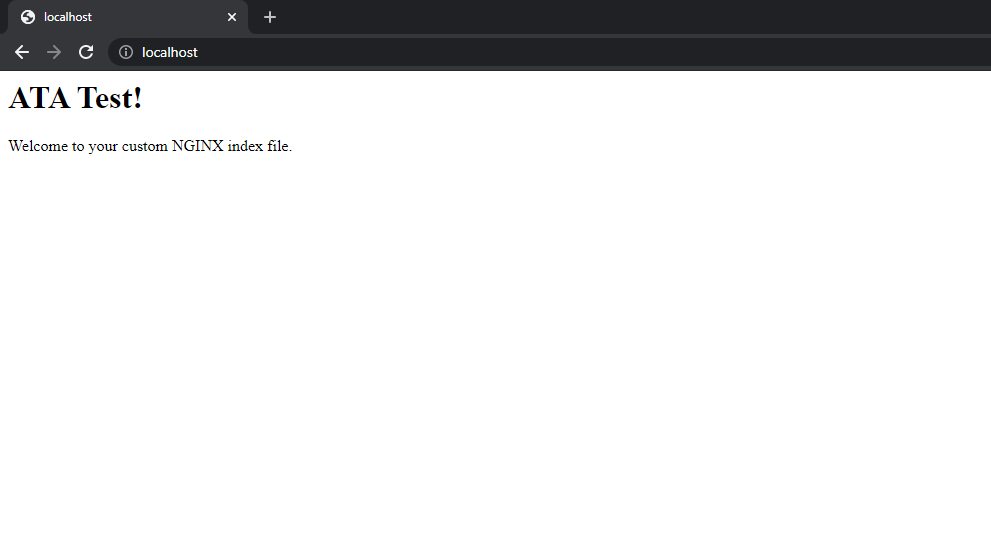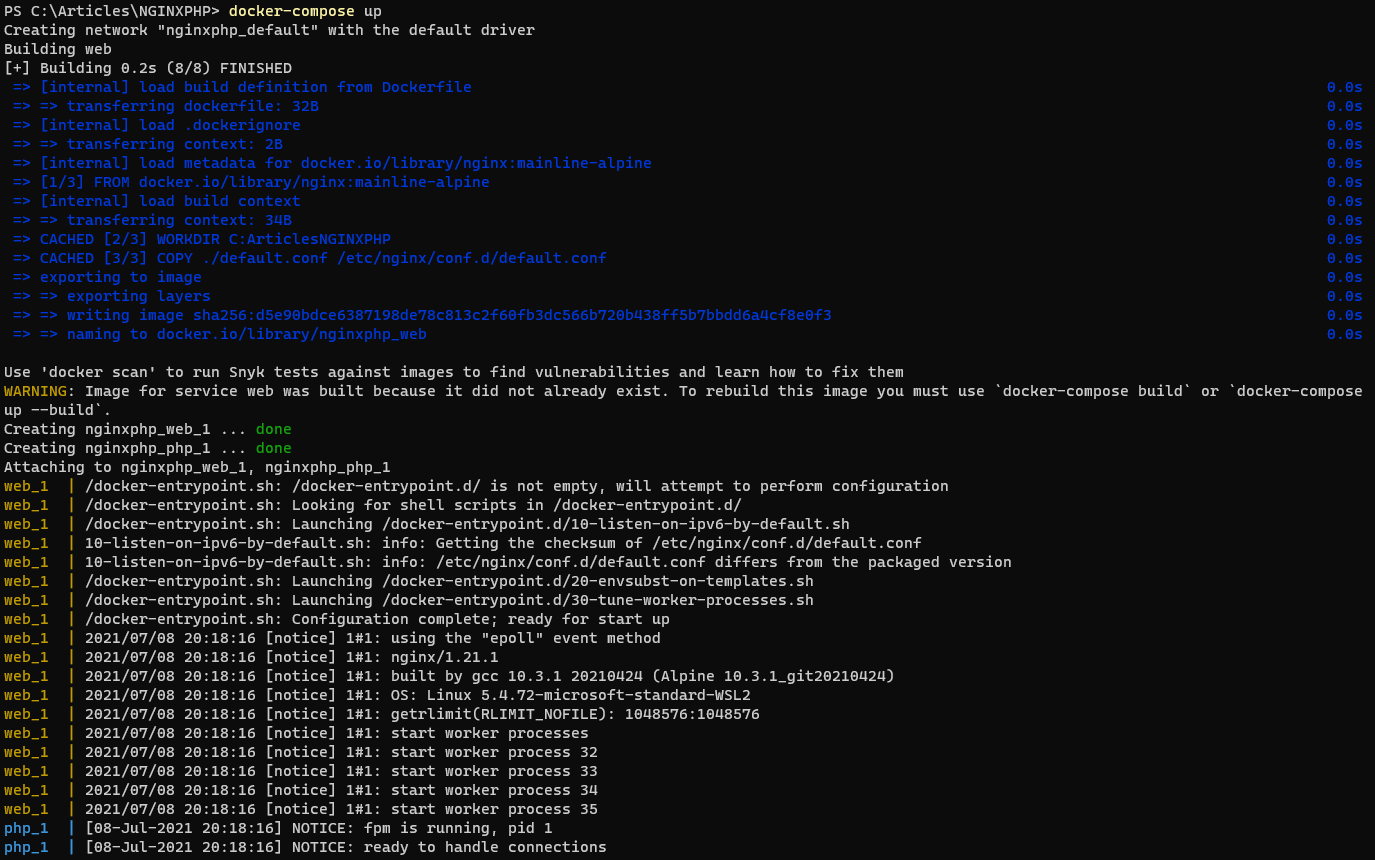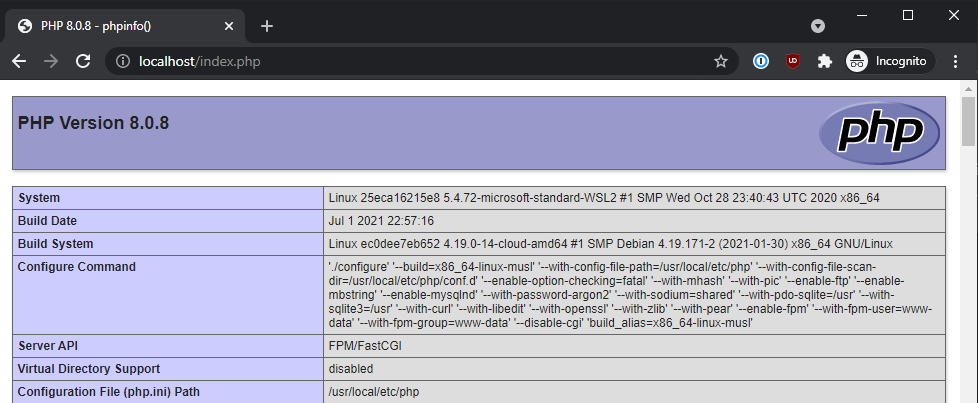Containerizing web server workloads, such as NGINX, has become common across the modern IT industry. NGINX makes a perfect container workflow and marrying NGINX to Docker is a perfectly logical task.
In this tutorial, you will learn how to provision a new NGINX on Docker container running on any operating system such as Windows, macOS, or Linux!
Prerequisites
To follow along with this tutorial, be sure you have the following:
- Docker Desktop – This tutorial uses version 3.5.1.
- Windows 10 – The tutorial uses Windows to run Docker on but the same general steps can also be applied to Linux or macOS.
- The Docker engine if you’re on Linux.
Provisioning an NGINX on Docker Container
Let’s get started by first creating a Linux Docker image with NGINX already installed. This tutorial will use a minimal Linux distribution called Alpine Linux running the latest NGINX version available, which is 1.21.1 in this tutorial.
1. First, open a terminal session where you will run all of the necessary Docker commands.
2. Run the docker pull command to retrieve, or pull, the latest nginx image from the NGINX Docker Hub repository using the mainlin-alpine branch. The Docker Hub is an open-source repository of Docker Images available to Docker users.
docker pull nginx:mainline-alpine
nginx:mainline-alpine Docker imageRetrieving the latest image is great for development and testing, but it is often a best production practice to specify a specific version such as
docker pull nginx:1.21.0-alpine.
3. Next, run the docker run command to run a container from the nginx:mainline-alpine image.
-i– This parameter requests an interactive console, which returns internal container output to the terminal.-t– Here you ask for a Pseudo-TTY console to the running container which allows the use of the key commandctrl-cto exit the interactive container.--name– The name of this container run, must be unique for each new container (unless prior containers of the same name are removed).-p– What internal to external port to use, which in this case the internal port of80should be mapped to the external port of80.- “image name” – What Docker image to provision the container from, in this case, the previously pulled
nginx:mainline-alpineimage.
docker run -i -t --name nginx-mainline -p 80:80 nginx:mainline-alpine
4. In a web browser, navigate to the running Docker container by going to http://localhost. If successful, you will see the default NGINX welcome page. Since in the previous step, you started the container mapping the external port 80 to the container’s port 80 (-p 80:80), NGINX should be available.

5. Finally, open your command line console again and hit the key combination of ctrl-c to exit the running container. You still have some work to do!
Mapping Website Files to a Container
At this point, you can easily bring up an NGINX Docker container with the sample webpage. You now need to upload your custom website to NGINX. Since containers are immutable and will purge any changes to them when recreated, you must provide a website source outside of the Docker image.
The NGINX web server running on Linux stores website files in the /usr/share/nginx/html directory. Rather than upload files directly to this directory, you should map a storage location to that location so that the container will pull those files from the storage location at bootup.
On your local host operating system:
1. First, create a directory to map to the NGINX Docker container. In this example, C:\Articles\NGINX is used to map to /usr/share/nginx/html.
2. In the newly-created directory, create a file, index.html, that contains the following. This file will be the file that NGINX serves up when navigating to the website.
<html>
<head></head>
<body>
<h1>ATA Test!</h1>
<p>Welcome to your custom NGINX index file.</p>
</body>
</html>3. Next, on the command line, invoke docker run with nearly all the same parameters as step three in the previous section. But this time, include the volume parameter, -v as shown below.
In the example below, the -v parameter is mapping the local C:\Articles\NGINX directory to the image’s /usr/share/nginx/html directory. Creating this mapping will allow you to modify the contents of the /usr/share/nginx/html container directory by modifying the contents of the C:\Articles\NGINX directory.
This demonstrates a Windows file location, but this command works the same on Linux. For example,
-v /usr/share/myfiles:/usr/share/nginx/html.
docker run -i -t -v c:\Articles\NGINX:/usr/share/nginx/html --name nginx-mainline -p 80:80 nginx:mainline-alpine
4. Finally, open a web browser and navigate to http://localhost. You will see the following displayed based on the newly created index.html file since it is now pulling files from the local C:\Articles\NGINX directory.

Running a PHP-FPM Application with a Docker NGINX Container
By now, you can bring up an NGINX Docker container and easily modify a website’s contents. If you need a super-basic setup, this might work. But, if you plan on running a web application on NGINX, you must do a little more work.
As an example, let’s enable the NGINX image just created to run the popular web scripting language PHP using PHP FastCGI Process Manager (FPM).
For this section, several new concepts must be introduced. To easily define a set of containers and their linkages, it is best to use a Docker Compose file. Docker Compose defines the series of services and related applications in a YAML (Yet Another Markup Language) file.
In addition, since you need to copy a custom configuration file for the default site, into the NGINX container, a custom version of the nginx:mainline-alpine image is needed. To extend an existing image, a dockerfile is used and built with the build step in the Docker Compose file.
1. Create a directory to contain your configuration files. In this example, the directory C:\Articles\NGINXPHP is used.
2. First, create the file, dockerfile, with the following contents.
# The image to pull the base configuration from
FROM nginx:mainline-alpine
# The directory where any additional files will be referenced
WORKDIR C:\Articles\NGINXPHP
# Copy the custom default.conf from the WORKDIR (.) and overwrite the existing internal configuration in the NGINX container
COPY ./default.conf /etc/nginx/conf.d/default.conf3. Next, create the file docker-compose.yml file, containing the following.
# The specification version of docker-compose
version: "3.9"
# The collection of applications composing this service
services:
# The NGINX custom container
web:
# Instead of referencing image: nginx:mainline-alpine here, use build to
# reference the current directory (.), which will look for a dockerfile
# by default
build: .
# The external directory location to map to an internal location
volumes:
- C:\Articles\NGINXPHP:/usr/share/nginx/html
# The external port mapping to internal port mapping
ports:
- "80:80"
php:
image: php:fpm-alpine
# It is important that both containers can reference the same files
volumes:
- C:\Articles\NGINXPHP:/usr/share/nginx/html4. Finally, create the NGINX configuration file, default.conf, with the following.
server {
# The port to listen on
listen 80;
# The root directory, which must exactly match the internal volume share
root /usr/share/nginx/html;
# For all files with the PHP extension run the following
location ~ ^/.+\.php(/|$) {
# Pass the request to the host "php" and port 9000 (default PHP-FPM port)
fastcgi_pass php:9000;
# Include the default NGINX FastCGI Parameters
include fastcgi_params;
# Define one additional parameter telling PHP-FPM where to find the file
fastcgi_param SCRIPT_FILENAME $document_root$fastcgi_script_name;
}
}You may wonder where “PHP” for the hostname came from. By default, a network shared by all applications contained in the service is created using the name of the parent directory. Each container is assigned a hostname equal to the application name. In this example, the network is
nginxphpand the hostnames arewebandphp.
5. In a terminal session, navigate to your custom Docker configuration file directory, which in this example is C:\Articles\NGINXPHP. Run the command, docker-compose up to generate and start your custom service.

6. Now that the set of containers are up and running, you need a PHP file to test the configuration out. Create the file, index.php, in your NGINX Docker shared directory which is C:\Articles\NGINXPHP in this tutorial.
<?php phpinfo(); ?>7. Open a web browser and navigate to http://localhost/index.php to verify that the PHP file is properly shown.

Conclusion
Docker NGINX containers are incredibly useful for testing and development. With proper care and attention, Docker containers can help to greatly increase a production web server’s capability as well!
Now that you have successfully provisioned an NGINX container and a linked PHP-FPM container, try adding a database container into the mix for a full web application environment.




